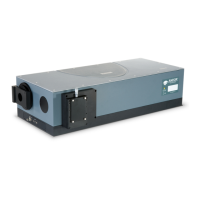Grating ne adjustment may become necessary after your Shamrock has been shipped, or otherwise moved. Whilst
every effort is made to limit the shifting of optical components during shipment, it is possible that some misalignment
may occur. Even a very small change in tilt of 0.03° will cause a signicant image shift of 10 x 26 µm pixels on an iDus
sensor. Once your spectrograph is securely located no further adjustment will be necessary. The following terminology is
used:
Yaw: This is movement of the grating rotating about a
vertical axis through its centre – illustrated, right, which
affects where the grating zero position lies. The zero
position of each grating may change by a small amount
during shipping, but this is accounted for using the
grating offset utility in the Shamrock control panel and
therefore physical adjustment of yaw is not necessary.
Roll: This affects how perpendicular the grating grooves
are to the system’s horizontal axis. The groves should
always be vertical; if they are not, different wavelengths
will fall at different heights on the sensor. Typically,
roll does not need to be adjusted after moving your
spectrograph.
Tilt: Tilt is the parameter most likely to need adjustment
after shipping/moving your spectrograph. A bre centred
at the middle of the entrance slit should produce an
image at the vertical middle of your detector. It is
sometimes found that the 3 gratings on a turret produce
images at 3 different heights. The tolerance required
depends on your experimental setup. For reference,
during Andor quality control testing, the adjustment is
made to ±5 pixels (26 µm pixels).
3.5.1.1

